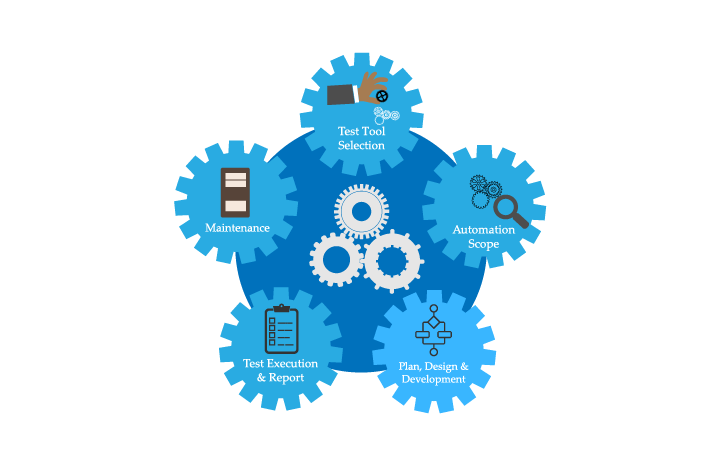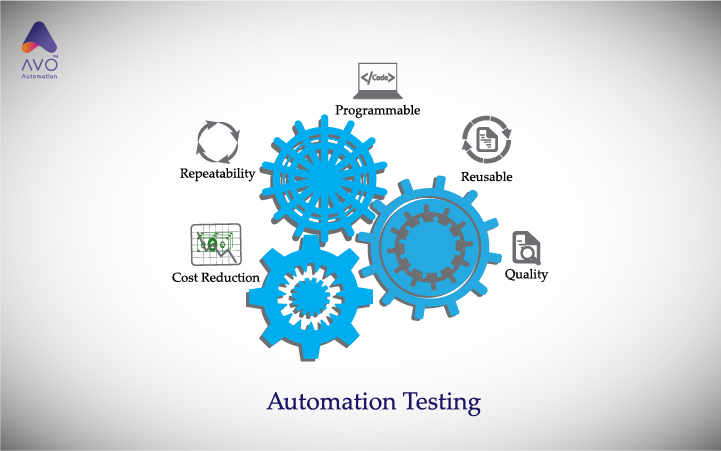Webinar
On-demand Webinar: The No-Code Test Revolution with Avo Assure
Webinar
On-demand Webinar: Transforming D365 Testing for Enterprises
Webinar
Live Webinar: Harness the Power of AI-driven No Code Test Automation with Avo Assure
Webinar
Webinar Replay: Empowering Test Automation with Avo & Oracle Cloud Infrastructure
Webinar
Lead Your Industry With Quality Software
Webinar
Optimize, Simplify, and Accelerate your Automation
Webinar
A simple and intelligent approach to test automation: Why, how, and what
Webinar
Modernizing Testing with an Agile and Intelligent Automation Approach to Quality Assurance
Webinar
Release quality software faster with test automation. Keep your business running
Webinar
No-code, no hassles: Achieve end-to-end test automation for SAP, Salesforce, and beyond
Webinar
Simplifying Oracle testing with no-code automation
Webinar
New Horizons: Navigating Tomorrow with Avo Automation and NewVision Software!
Webinar
On-demand Webinar: Mastering SAP Automation with Avo Assure
Webinar
On-demand Webinar: Women in Tech The Future of Quality Assurance
Webinar
On-demand: The State of Automation and What’s Next
ebook
A Step-by-Step Guide to Implementing Test Automation in Microsoft Dynamics 365
ebook
Oracle Fusion Testing Key Trends to Watch Out in 2025
ebook
How to Build a Comprehensive SAP Test Automation Strategy in 2025?
ebook
The Cost of Maintaining Test Automation for Enterprises: A Comprehensive Guide to AI-Driven Impact Analysis
ebook
Test Automation in DevOps: A Comprehensive Guide
ebook
The Definitive Guide to Test Data Management
ebook
The Definitive Guide to Test Data Management
ebook
Test Automation Strategy For Beginners
ebook
10 Benefits of Test Automation
ebook
The Ultimate Guide to Automated Regression Testing
ebook
How Automation Simplifies and Speeds up your Migration Journey to S/4HANA
Product Sheet
Avo Assure Product Sheet
Product Sheet
Microsoft Dynamics 365 Product Sheet
Product Sheet
Avo for Salesforce
Product Sheet
Avo for SAP
Product Sheet
Avo for Guidewire
Product Sheet
Avo for Oracle
Whitepaper
Managing Large-ScaleOracle Fusion ImplementationsThrough Test Automation
Blog
Test Automation Trends to Watch Out for in 2025: A Strategic Perspective
Blog
Avo Assure: Driving DORA Compliance for Financial Institutions with Test Automation
Blog
What is Negative Testing and how to Automate it?
Blog
What is Functional Testing?
Blog
Test Automation Strategy – what is it?
Blog
5 Things You Gain With Continuous Testing
Blog
What is Enterprise Application Testing Software
Blog
What is the Future of Automation Testing?
Blog
Tips for Successful Oracle EBS Test Automation
Blog
The Four Key Ingredients for Successful Test Automation
Blog
How to Build an Awesome Test Automation Strategy
Blog
7 Ways Test Automation Elevates Teams
Blog
Future-proofing QA: Embracing Gen AI with Avo Assure
Blog
Top 3 Reasons Businesses Should Automate in 2021
Blog
Unlocking 2x Value: The Strategic Advantage of Automating SAP Application Testing with Avo Assure
Blog
Unlock the Key Features of Microsoft Dynamics 365 with Test Automation
Blog
3 Industry-approved Techniques You Can Use to Error-proof SAP Applications
Blog
Best Automated QA Software Testing Tools
Blog
Automation Testing Interview questions
Blog
Automated QA Testing: Best Practices to Enhance Software Quality
Blog
Web and Mobile Application Testing
Blog
Will Test Automation Replace Manual Testing?
Blog
Why Oracle Fusion Cloud Needs Automated Testing for True Business Transformation
Blog
How to Improve the Efficiency of Your Microsoft Dynamics 365 System with Test Automation
Blog
What is Integration Testing?
Blog
Exploring Test Automation Trends: Insights from The Avo Prodcast Season 1 Episode 1
Blog
Back to the Basics: What is automated testing?
Blog
How to Automate Testing in Insurance? 3 Tips to Lead Your Industry
Blog
Software Testing Automation: Everything You Need to Know
Blog
Shift Left Testing: Everything You Should Know About It
Blog
Women in Tech: Pioneering the Future of QA with AI and Automation
Blog
AI in Testing: The Future of Automation Testing
Blog
How to Convert Manual Tests to Automated Tests?
Blog
Automated testing for Microsoft Dynamics 365 applications using Avo
Blog
What is Gap Analysis in Software Testing?
Blog
The Top 7 Software Testing Companies in the USA
Blog
The definitive guide to automation testing on cloud
Blog
Codeless Test Automation and Its Benefits
Blog
Important SAP Test Case Scenarios to Automate in 2025
Blog
No-code Test Automation: Advantages, Challenges, and Future
Blog
Manual vs. Automated Testing for Oracle: The Cost of Falling Behind
Blog
Business Process Testing – A Comprehensive Guide
Blog
GUI Test Automation: Why, how, and what
Blog
Detailed Guide on Intelligent Test Data Management Software Tools
Blog
Introducing Avo GenAI: Revolutionizing Software Testing with AI approach
Blog
SAP S/4HANA: Transforming Business Operations and the Crucial Role of Test Automation
Blog
Choosing Wisely: Is Generative AI the Missing Puzzle Piece in Your Automation Strategy?
Blog
Agile Test Automation: Rise of Continuous Testing in Agile
Blog
When Should A Test Case Be Automated
Blog
Unlocking the Future of D365 Automated Testing: Why Avo Assure is Your Ultimate Solution
Blog
Continuous Testing – The Modern Approach to Application Testing in Your CI/CD Pipeline
Blog
Exploring Test Automation Platforms: Features, Benefits, and Implementation Tips
Blog
Unlocking the Power of No-Code Test Automation: A Comprehensive Guide from Avo
Blog
Avo is named a key vendor for Test Automation by Gartner
Blog
Try Avo Assure Now and Automate Your Dynamics 365 Regression Testing in Minutes
Blog
The Future of Marketing Automation
Blog
What Test Automation Metrics Does Your Product Need?
Blog
How to Improve the Effectiveness of Test Automation in Agile?
Blog
No Code Testing: Practical Tips for Non-Technical Testers
Blog
Best AI Test Automation Tools for QA Testing in 2024
Blog
Reviving the Excitement: Highlights from the Avo Partner Conclave 2023!
Blog
6 Reasons Test Automation is a Game-changer for IT
Blog
Agentic AI & Test Automation: A Strategic Leap Forward for Enterprises
Blog
The Top 11 Software Testing Communities Worldwide: A Comprehensive Guide
Blog
These Five Test Automation Best Practices Will Transform Your Testing Strategy
Blog
Brainwave to Inbox: Avo’s Whimsical Adventure through AI-Powered Test Automation
Blog
Mobile App Automation Testing with AI: Detailed Guide
Blog
6 Best Software Test Automation Tools in 2024
Blog
AI Will Eat RPA For Lunch: Avo’s Top 4 Automation Predictions for 2022
Blog
Can Agile Testing Survive Without Test Data Management?
Blog
Beyond the Hype: Can Generative AI Truly Revolutionize Test Automation?
Blog
Microsoft Dynamics 365 Testing Best Practices: Ensuring Success in the Digital Transformation Era
Blog
Busting the Common Myths of Test Automation
Blog
Is Test Automation Worth it?
Blog
How to Calculate Automation Test Coverage?
Blog
Test Automation for Salesforce – Challenges and Best Practices
Blog
How to Select Regression Test Cases?
Blog
Test Automation & Tools for MS Dynamics 365
Blog
When is Regression Testing Required?
Blog
Avo Assure for Test Automation Achieves Top Oracle Certification
Blog
Can Test Automation Improve Test Effectiveness?
Blog
Future-Proofing Oracle Testing with AI and No-Code Automation
Blog
Handle end-to-end application testing like a Pro
Blog
How to Estimate Test Automation Efforts in Agile?
Blog
Core Strategic Advantages of SAP Test Automation
Blog
How test automation helps the healthcare industry?
Blog
How to Prepare an Automation Test Plan?
Blog
What to Look for and Consider in an SAP Test Automation Tool: A Strategic Guide for Decision Makers
Blog
7 New Features of Avo Assure That Make Your Life Easier
Blog
Benefits and importance of CI/CD integration in testing
Blog
What’s End-to-End (E2E) Testing | Significance & Best Practices
Blog
How to achieve a smooth test automation process with in-sprint automation?
Blog
5 Questions to Ask Vendors Before Choosing an Oracle Test Automation Tool
Blog
How does AI self-healing test automation shape the future of test automation?
Blog
End-to-end Testing Made Simple
Blog
Test Data Management: Challenges and Solution
Blog
Factors Responsible for Test Automation Failure
Blog
Web Test Automation in 2025: Best Practices
Blog
Navigating the Top Challenges of Automating SAP Fiori Testing
Blog
Best Practices for Effective Test Data Management
Blog
The Oracle fusion cloud testing challenges and How to Overcome Them
Blog
Oracle Test Automation Plan 2025: The Roadmap to Seamless Transformation
Blog
Continuous Testing of Dynamics 365: The Key to Seamless ERP Performance
Blog
Benefits of Test Data Management
Blog
Manual Vs. Automated Testing
Blog
SAP ECC Test Automation 101: Core Functional Components | Best Practices | Test Automation Solutions
Blog
Test Data Management Strategy
Blog
Which Test Cases Should You Not Automate
Blog
Why Oracle Test Automation is a Game-Changer for Complex ERP Systems
Blog
Best Practices for Agile Testing in 2024
Blog
Accelerate Cloud Migration with Test Automation
Blog
How Automated Testing for Oracle Fusion is Crucial for Your Business Transformation
Blog
Enabling DevOps Through Continuous Testing
Blog
Automated Accessibility Testing: Core benefits and features
Blog
Test Automation Plan and Why Should You Create One
Blog
Maximizing Employee Productivity with SAP SuccessFactors
Blog
Why Test Data Management?
Blog
Rise with SAP Test Automation
Blog
Demystifying the differences between manual and automated testing
Blog
What is Automated Web Testing?
Blog
What is Automated Testing in Agile?
Blog
What is Data Obfuscation?
Blog
Oracle Fusion Testing 101: Best Practices, Scenarios, and Driving Automation Excellence
Blog
Why Test Automation is Essential for Agile Teams
Blog
Driving SAP Testing ROIs with Avo Assure
Blog
What is User Interface Test Automation?
Blog
How Many Test Cases Can Be Automated Per Day?
Case Study
Church & Dwight Co., Inc. Simplifies Testing Procedures using Avo Assure
Case Study
Large Fortune 500 Bank Saves 63% Costs With Test Automation
Case Study
Fortune 500 Manufacturing Company Reduces Project Costs by 25%
Case Study
A Fortune 500 Medical Manufacturing Company Achieved 65% Cost Savings With Avo
Case Study
Fortune 500 Manufacturer Gets to Market 5x Faster and Improves SAP Application Quality
Case Study
Leading Financial Institution Delivers Applications 2x Faster with Zero Defects
Case Study
CNA Insurance Improves Automation Rate by 10x and Enables DevOps for Rapid Delivery in Just 2 Months
News
Avo Assure Achieves Top Oracle Certification
News
Avo Automation Enters Next Phase of Growth with New Leadership Team and Innovative Initiatives
News
The Real Bottleneck to Agile Delivery
News
Avo Automation and InfoVision Announce Strategic Partnership
News
Avo Automation Announces Continued Momentum Through New Leadership Appointments, Expanded Coverage and Customer Benefits
News
Why CNA Insurance Chose to Automate with Avo – 5 Questions with their CIO
News
Avo Automation Announces Strategic Partnership with Mannai InfoTech in Qatar
News
SLK Software launches Avo Automation
News
Annalisa Camarillo featured in the Forbes Ignite Report: C-level Women in Sustainability
News
Annalisa Camarillo Named Top 10 Most Empowering Women in Technology by Industry Wired, 2021
News
Avo Automation Increases Momentum as Companies Rapidly Adopt Test Automation
News
Avo Automation and Unqork Announce Strategic Partnership
News
Avo Automation Announces Strategic Partnership with Enhance Consulting To Offer Exclusive Service Offerings
News
Avo Assure Now Available on SAP® Store
News
Avo Automation and Ameri100 Announce Strategic Partnership To Offer Exclusive Service Offerings
Event
Rendezvous for Avo Community
Event
Rendezvous for Avo Community
Event
Experience the Next-Gen AI-Empowered Software Testing at STAREAST 2024!
Event
Avo & NewVision: Gold Sponsors of EuroSTAR 2024
Event
Avo is the Proud Event Sponsor for the STeP-IN Summit 2023
Event
Avo is excited to be a Gold Sponsor of the SAP ALM Summit APJ 2024!
Event
AFL Felicitation Ceremony
Event
Avo Partner Conclave 2023

























.png)








































































































































































